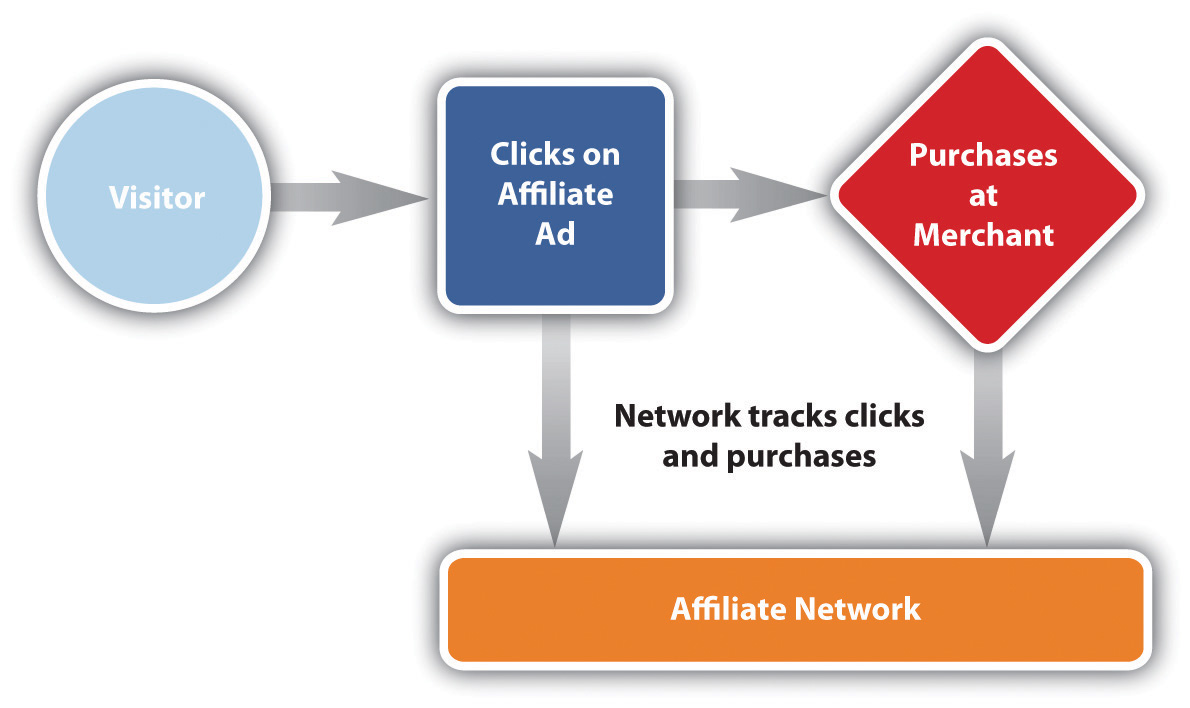The core of affiliate marketingAn agreement between two sites in which one site (the affiliate) agrees to feature content or an ad designed to drive traffic to another site. In return, the affiliate receives a percentage of sales or some other form of compensation generated by that traffic. is a simple process:
Figure 4.1 The Affiliate Marketing Process

However, there are many different ways an affiliate might market a merchant’s offering, there are many different types of action that can be rewarded, and, most importantly, there needs to be some way of keeping track of the whole process.
We’re going to take a look at the different types of actions first of all, then discuss keeping track of it all, and lastly take a look at some of the many means that affiliates use to send customers to merchants, and of course, to make themselves cash.
Affiliate marketing can be used to promote any type of Web site—there just needs to be an agreed-upon action that will result in an affiliate earning commissionThe bounty paid by a merchant to an affiliate when the affiliate makes a successful referral.. Different types of merchants will have different required actions. The actions and the types of commission can be summarized in the following:
Let’s look at an example of each of these actions.
Here the action could be anything from downloading a white paper or software to signing up for a newsletter.
Why do you think a merchant would be willing to offer a bounty for each download?
Merchants that offer CPL commissions are usually those that need to convert a lead into a sale offline. This means that they will generally need to complete the transaction over the phone with the customer or that the process is quite complicated. It is typically insurance companies and banking institutions that will offer this type of commission.
Membership sites that offer a free trial period, such as online DVD rental businesses, can also use this commission structure.
You might be wondering why merchants are willing to pay for a lead instead of only for completed transactions.
How do you think companies can ensure that the leads they get are qualified?
Well, affiliates prefer this model, as they are not in control of the offline conversion process. It is the merchant’s job to be able to complete the transaction. Some merchants may be wary that the leads will not be of a high enough quality. This is why they will usually have conversion targets with which the leads generated need to comply as a means of quality control.
Revenue sharing is the ideal commission structure as both the merchant and the affiliate are rewarded for performance—the more sales, the more revenue generated for the merchant and the more commission for the affiliate. Web sites where a sale can be performed instantly are ideal for revenue sharing. Online retailers and instant online travel agents are perfect examples of merchants who offer a revenue share commission. The affiliate earns a percentage of the sale.
Figure 4.2

Amazon Associates is a popular revenue share affiliate program.
CPC commission is rarely used and is primarily a way of driving large volumes of trafficThis refers to the visitors that visit a Web site., usually to a new site. An affiliate would be awarded commission for every click-through to the merchant Web site. Although this type of commission was prevalent in the very early days of affiliate marketing, it has been largely abandoned due to click fraud. Click fraud occurs when a link is clicked on by a bot, or someone paid to click on links (see Chapter 7 "Pay per Click Advertising").
We have seen that there are different types of actions that can result in commissions being awarded and that these actions usually suit the Web site that is being promoted. This means that any industry that is online can most likely be promoted through affiliate marketing.
Affiliates have many options open to them to promote merchants’ Web sites. But before we get to that, we need to take a look at tracking—the thread that holds it all together.
There are different types of commissions whose uses are based on the merchant’s industry: